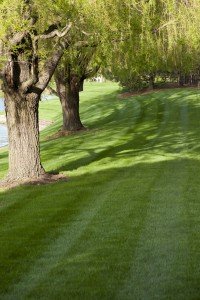How Do I Get More Shade in My Backyard?
Gorgeous, abundant sunshine can cast a complementary glow over your landscape. Too much sun exposure, however, is detrimental to your health and open air enjoyment, as well as the strength of your yard’s shade-loving plants. Luckily, getting more shade in your backyard is easily achievable with natural and man-made methods. Protect yourself and your landscape for long-lasting outdoor satisfaction, no matter how sunny or hot it gets.
Backyard shading generally falls into two categories: trees and structures. Shade trees are available in a wide range of species for aesthetic and climate versatility. Going all-natural is the cheapest and often preferred route, since trees release moisture and oxygen, and offer cool breezes when the wind blows. Man-made shade structures, on the other hand, may be permanent or temporary and can add unique design elements to your backyard. Unlike trees, which may take upwards of 20 years to mature, shade structures provide a quick-fix.
Shade Trees
Canopied trees are a practical and visually pleasing solution for an overly sunny yard, decreasing temperatures below by up to 10 degrees. Make sure your planting location contains fertile soil, receives the proper amount of sunlight for healthy growth, can accommodate your tree’s height and root system at full maturity, and isn’t obstructed by power lines or other utility structures. To attain natural shade fairly quickly, many homeowners select fast-growing species such as paper birch, red maple, and American sycamore, which can increase several feet in height annually. Still, quick-growers don’t always develop the strongest root systems, so consider whether a shorter lifespan will suit your needs. Need help picking the right trees? Learn more about working with an arborist in this related article.
Shade Structures
Man-made shade structures come in a slew of types and styles to match your home and landscape design. If trees are not an option for getting more shade in your backyard, or you simply want to diversify shading techniques, employ the aid of permanent and temporary structures.
Permanent Structures
Pergolas & Patio Covers
Pergolas are four-sided, freestanding structures with no walls that are generally used to cover an outdoor room or walkway. Patio covers serve the same purpose, but, because they are built off the main home, are less costly to construct and maintain.
Gazebos
Freestanding gazebos typically have eight rounded sides and may be completely open or partially closed, but are always covered with a roof. Gazebos offer charming additions to French- or English-style gardens.
Pavilions
A pavilion is a freestanding structure with open sides and a pitched roof. Usually, pavilions are large enough to house entire outdoor kitchens or entertaining areas which necessitate ample space for appliances, hardscaping, and decorative features.
Temporary Structures
Umbrellas
Umbrella installation is one the fastest and simplest ways to get more shade in your backyard. Choose from an assortment of colors, textures, and weights to precisely match your aesthetic and functional needs.
Shade Sails
Rectangular or triangular shade sails are a stylish and inexpensive option for keeping harsh sunshine at bay. Attach PVC or shade cloth across poles, tree branches, or your home’s roof to block out tricky sun patterns. Shade sails fixed at varying heights also create a wonderfully layered effect that adds dimension to your yard.
Getting more shade in your backyard doesn’t have to be a difficult task. Go natural or man-made for spectacular shading results that will keep you outdoors all day.

